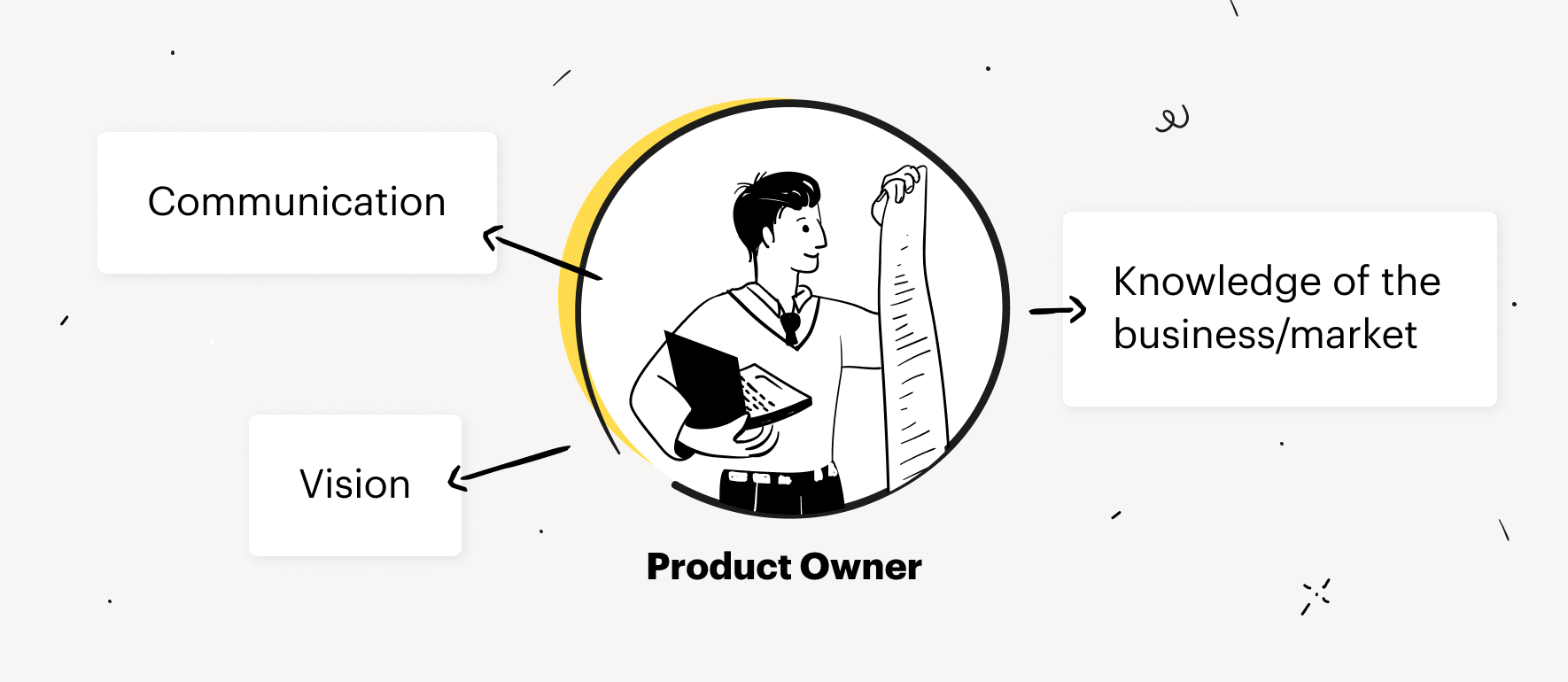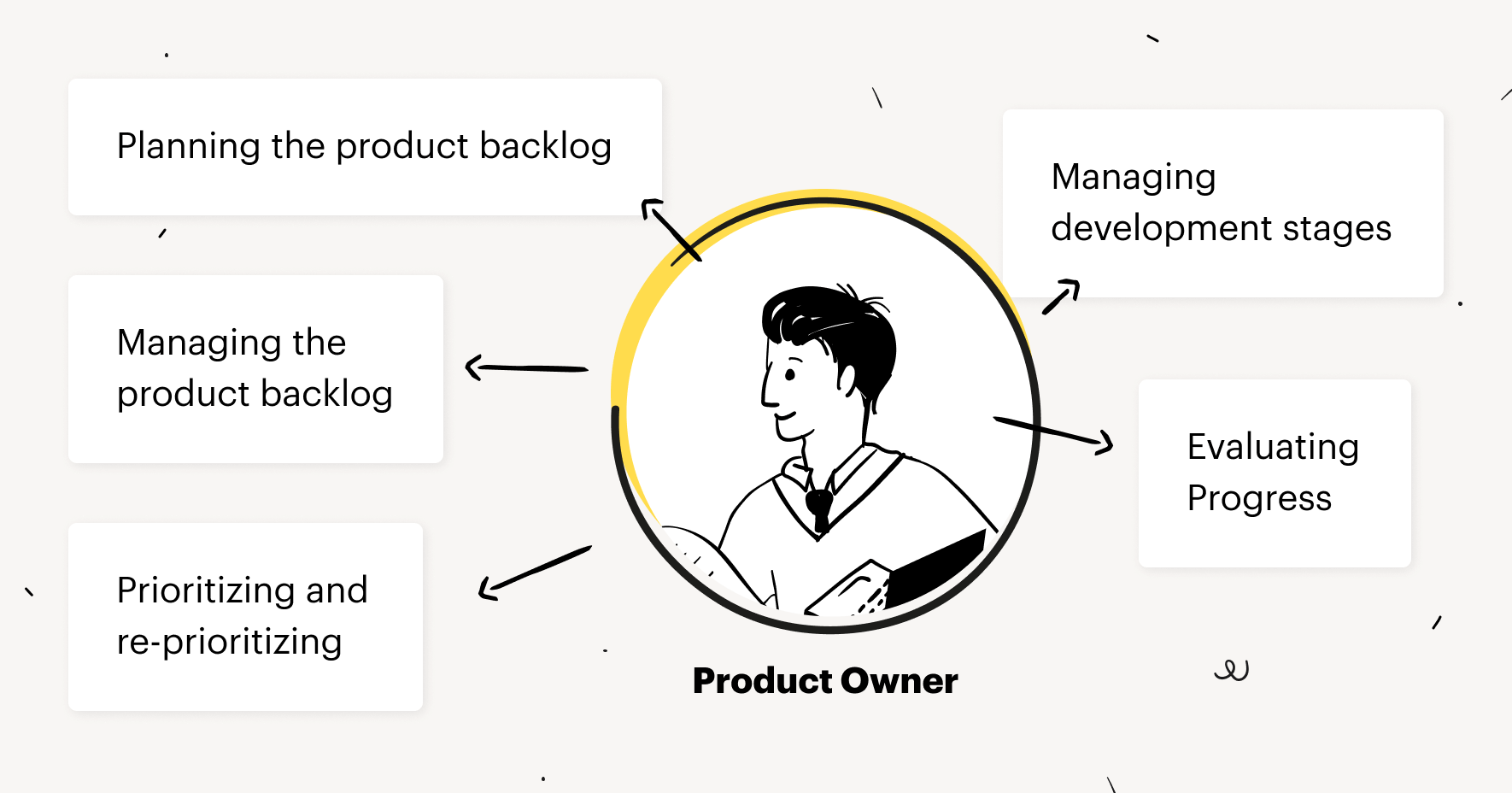Scrum Product Owner Responsibilities

1. What is the Scrum Product Owner?
What a Scrum Product Owner is can be misinterpreted. The Product Owner in a Scrum project is not necessarily the final end client or customer, it is actually the person who takes ownership. Therefore, the Scrum Product Owner bears the overall responsibility for the success or failure of a project. Whilst this can be the future owner of the product, it can also be someone who is designated and chosen for this role.
Scrum is essentially a team effort, but there is an emphasis on individual accountability of each particular specified role. The Scrum Team is broken up into three vital and interconnected components. Alongside the Scrum Product Owner are the Scrum Master and the Scrum Development Team. The Scrum Product Owner’s responsibilities are wide-ranging and a central feature of any Scrum project. Within the actual development of the project and as a link between the Scrum Team and other interested parties.
The actual role will depend on the product and the environment and the business field. Albeit, in all cases, the Scrum Product Owner is the person who has the final say on key decisions. They are also the single point of liaison with external interests outside the Team setting.
2. Product Owner Responsibilities
2.1. Outside the Scrum

Before the Scrum even starts The Scrum Product Owner has to establish what the Scrum is trying to achieve. They have to build links between the external interested parties. They also have to have a full picture and overview of what is the expected results and definition of success.
#1: Knowledge of the business/market
The Product Owner is either the owner of the future product or the representative of that owner. This means that the Scrum Product Owner’s role needs to include an understanding of the market and the business in order to take the idea of the product and help turn it into a viable product. There needs to be a return on investment. This involves not only understanding what the client wants to achieve but also offering advice and experienced input. The Scrum Product Owner is often referred to as “the ideas man”, this may be the original idea or the practical vision of the idea but either way it needs to be based on sound business strategy.
#2: Vision
The Scrum Product Owner needs to have a comprehensive understanding of what exactly the client wishes to achieve with the product. They have the responsibility of clearly defining this to the rest of the team. Good communication and collaboration with the client are essential. The Scrum Product Owner needs to understand and make understood the product goals in order to be able to plan the direction of development through to successful completion. With this vision firmly kept in focus, the Scrum Product Owner has the overall responsibility for keeping all the stakeholders informed of progress and feeling part of the process.
#3: Communication
The Scrum Product Owner is the single point of communication between the team and the external stakeholders, such as other managers, customers, clients, marketers, etc. This link is vital in Scrum firstly to clearly define expectations and vision and secondly to keep everyone on the same page and up-to-date with progress. During the Sprints, the Product Owner is also responsible for inviting interested parties to Scrum Reviews.
2.2. During the Scrum

Once the vision has been agreed upon, and the essential expectations negotiated the Scrum is formed to do the actual work on the project. Whilst the Scrum Product Owner has still to keep liaising and communicating with the outside or external stakeholders, they also have a role and responsibilities within the Scrum team.
#1: Planning The Product Backlog
The Product Backlog is the term used in Scrum for the plan or to-do list for the project. The Scrum Product Owner is responsible for the creation of the list of tasks to be done and the order in which they should be done. This is usually done in combination with the Scrum Master, who often has extra technical knowledge and input. However, it is the Product Owner’s responsibility to come up with the task breakdown and to map out the road or pathway to the final completed product. This plan needs to be an efficient and logical sequence of practical objectives. It is also important within Scrum that these tasks are prioritized.
#2: Managing The Product Backlog
In Scrum, the Product Backlog is not a set concrete formatted process. Instead, it is an active and flexible working base. This backlog can and will change as the project develops and it is the Scrum Product Owner’s responsibility to manage this Product backlog and keep it evolving so that the project can move forward. The Product Owner needs to be on top of this process. to avoid blockages.
#3: Prioritizing and re-prioritizing
The Scrum Product Owner has planned the task and prioritized them taking into account the external stakeholders and the opinions of the Scrum Master. Once the Scrum kicks off there will be times when things will need to be changed. Others will and are expected to have input but it is the Scrum Product Owner who makes the final decisions on re-prioritizing and even adapting, or changing the scope.
#4: Managing blossoming stages
The Product Owner has a role to play and a responsibility to be part of the actual development process. This means the Product Owner takes part in the Scrum meeting, especially the planning, review, and retrospective meetings. This gives the Scrum Product Owner an overview of what is happening. The Scrum product owner has to be a visible presence. They can and should be involved in clarification, and answering queries of the development team in meetings. They should also work with the team helping to locate areas for improvements in the processes, supporting the team, and if needed allocating extra resources.
#5: Evaluating Progress
The Product Owner is responsible for the final say on whether or not Sprint is good enough. This will decide if it is ready for demonstration and therefore releases.
Conclusion
A Scrum Product Owner has to wear many hats; a clear, concise communicator, a business expert, a marketing strategist, an administrator and planner, a part of the team but also the link with the senior managers or clients. The roles are numerous and the responsibilities enormous. However, the potential rewards are not just in salary and position but also in the satisfaction of seeing the product come alive. Not easy but it is worthwhile.